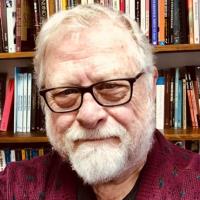Commentary on Mark 8:27—9:8
The first half of Mark’s story takes place in Galilee, with Jesus restoring the health of individuals and village communities.
This mission climaxes with Peter recognizing Jesus as Messiah. From this moment the narrative shifts its attention from the provinces to the capital, from effects to origins, from symptoms to causes (Mark 8:29).
Lifted beyond the mundane
Shortly after Mark’s narrative turns its attention toward Jerusalem, Jesus takes three of his disciples up a tall mountain, where he is transfigured. The atmosphere is rarified, and the three disciples are awe-stricken. This experience of the transcendent brings them into contact with the ultimate meaning of the story in which they find themselves. The sacred mountain associated with Moses and Elijah called to mind, as the two famous figures encounter Jesus on the summit.
Jewish tradition knew of famous figures who were taken in heaven without dying. The Bible mentions Enoch (Genesis 5:24) and Elijah (2 Kings 2:11). And although Moses’ death is reported there (Deuteronomy 34:5-6), the Jewish philosopher Philo and historian Josephus record the tradition that he was taken up bodily. Jewish apocalyptic writing speaks of persons, like Enoch, who are transformed in the heavenly realm, or who already glow with a divine radiance. And in biblical tradition, Moses’ face was radiant after his encounter with God on Sinai (Exodus 34:29-35).
Also, Moses and Elijah evoke “the law and the prophets,” the biblical name for the Hebrew Bible. The inescapable implication of their presence here is that Jesus is endorsed by scripture, as well as fulfilling its promise. The narrator is pulling out all the stops to emphasize the point that what Jesus is about to do in Jerusalem is part of a divine plan. And it stands as an assurance that the dark experiences in the chapters about to occur do not represent the final meaning of the story.
A mountain in the middle of the story
The Mount of Transfiguration is traditionally sited at Mount Tabor, a flat-topped extinct volcano cone, east of Nazareth in the Jezreel Valley. If you should take the winding road to the top, you will find there a basilica and, perhaps to your surprise, a Crusader castle. You can see a long way from there.
And that is true of the episode in Mark. In part, it looks ahead to the empty tomb, and the resurrection of Jesus. The “young man, dressed in a white robe” at the tomb (Mark 16:5) speaks from a realm transcending the mundane world, and his clothing tells us that. So, it is with the clothing of Jesus, dazzling beyond what any earthly bleach could manage. For the participants, as well as the reader, this points us to an ending beyond what seems the ending, a life beyond death. That is where the story Mark is telling will take us.
The voice from heaven
In addition to peering ahead toward the ending, the Transfiguration story also looks back to the beginning, and the baptism event. The voice heard then makes a reprise (Mark 1:11; 9:7). At the baptism, the voice from heaven cited scripture and, in Mark’s typical fashion, combined different biblical passages. The citation of Psalm 2:7 identifies Jesus as Messiah— “You are my Son…” But Isaiah 42:1 complicates that identification with another, that of the suffering Servant of Yahweh, “with you I am well pleased”. King and slave; domination and service. Yes, he will be Messiah, but he is called to perform that role as the Servant.
The Galilee part of Mark’s narrative has just concluded, with Peter’s recognizing Jesus as the Messiah (Mark 8:29). But in the terms of the common understanding, following Psalm 2, he imagines a conqueror of dominating power. So, it is with surprise and disappointment that he hears Jesus say that he will be going to Jerusalem to suffer and die, and then be raised. He protests, and argues with Jesus.
That sets up the drama on the mountain of Transfiguration. The voice from heaven settles the dispute in Jesus’ favor. “This is my Son, the Beloved; listen to him!” The citation of Isaiah 42:1 is not repeated (as it is, for instance, in Matthew’s account). Instead, the injunction to listen to Jesus sets up the following lessons on the road to Jerusalem, as Jesus instructs his followers on the meaning of servant discipleship.
In the context of the gospel, the transcendent experience on the mountain takes us behind the surface of the narrative. Situated halfway through the story, just as things are about to turn toward the immensely difficult, the disciples, and ourselves in their company, are both warned and consoled about living through those difficulties toward fulfillment of the promise, through death to life.
Lessons might include:
- The description given here emphasizes the temporal character of hope, looking back to the promise, and forward to the fulfillment. In the time-bound form of narrative—and our human experience—it offers assurance beyond present sorrows, present trauma. It looks to a final victory that carries us through.
- In addition to unfolding in time, the Transfiguration account also gets a glimpse at the story behind the story. It presents the ultimate world that lies below the surface of the unfolding experience of our lives. In this regard, it is not unlike the vision of Paul in Colossians 3:1-4, where he sees the believers as having died and risen with Christ, though as yet in a hidden manner.
- The story invites us to join the story of Jesus as followers. The life of discipleship is one of living the gospel narrative. Following Jesus, as he requests, means living the story that is given us, accepting the role of the servant as he did.
PRAYER OF THE DAY
Lord of light, as you were transfigured on the mountain, your followers were given a glimpse of your glory. Shine your light in our lives so that we will know how truly marvelous you are. Amen.
HYMNS
Beautiful Savior ELW 838
I want to walk as a child of the light ELW 815, GG 377, H82 490, UMH 206
CHORAL
Christ upon the mountain peak, William Beckstrand


February 23, 2020